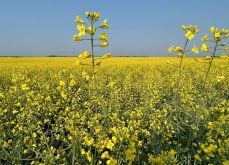Favourable commodity prices might tempt producers to work more canola into their crop rotations, but good prices haven’t changed the science.
Crop rotations are still a good idea, Agriculture Canada researcher Neil Harker reminded producers at a canola industry meeting in Sask-atoon Dec. 7.
“For us, it’s easy to say. For them it’s harder to do economically,” said Harker, who acknowledged it’s a difficult decision for producers looking to recover from bad years.
Demand for canola is growing, with biodiesel feedstock among the factors driving the demand. Harker said canola production in Canada averages 13 million tonnes per year, while demand is expected to increase to 15 million tonnes by 2015.
Read Also

StatCan stands by its model-based crop forecast
Statistics Canada’s model-based production estimates are under scrutiny, but agency says it is confident in the results.
“We could’ve done better than that this year had the year been better in some places in terms of excess moisture and late seeding.”
He said producers are shortening their rotations to meet the growing demand, but that increases the risk of disease, weed and insect pressures.
He conceded that a one-in-four rotation isn’t realistic, recommending instead a one-in-three rotation rather than the more common one-in-two, canola-wheat option.
“But even that is much, much better than continuous (canola).”
Harker said a rotation can also benefit canola yields. Research shows that canola yields are generally lower when there’s no break in the rotation.
Rotations also bring herbicide and disease resistance benefits.
“Crop rotation enables herbicide rotation,” said Sean Dilk of Monsanto.
The company recommends the use of 2,4-D or Heat as a pre-seed or pre-emerge tank mix during non-canola phases, which helps control the spread of volunteer glyphosate-tolerant canola.
Adding a wheat, barley or pea crop can also help reduce root maggot pressures because when canola is more common, so too are the pests. Managing root maggots biologically also means less pesticides, he added.
As well, pulse crops can offer diversity while helping producers reduce nitrogen costs, although Harker said these savings wouldn’t cover the revenue returns from another canola crop.
“Financially, if you look at nothing else, continuous canola looks pretty good,” he said.
















